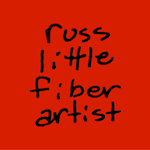Spinning off in new directions
For years I’ve observed that some of my best teachers have been the ones who mixed theory and practice, but also encouraged “what if” thinking. To be sure, there are some student curiosities that need to be discouraged. For example, “I wonder what will happen if I mix these chemical solutions?” can lead to danger, injury, or worse. Other what-ifs might be a waste of time or materials. From my own area of study, if someone said to me, “I wonder what would happen if I tried to dye this cotton fabric with acid dye?” I would say that’s an interesting question, and the answer is that nothing useful would happen because acid dyes don’t react with cotton or other cellulose fibers so you’d get a stain, but not a permanently set color. BUT, there are bunches upon bunches of other questions that a curious person might investigate that could lead to some profound experiential learning, especially under the guidance of a good teacher—and, I am a curious person.
My first full skein of handspun yarn. It’s 2-ply merino, corriedale, and mystery wool, variable in size, but mostly chunky overall. I’m working on spinning thinner.
Sometimes my curiosity leads me astray. Sometimes it leads to interesting personal discoveries that alter my path in ways that ultimately alter my destination. In a previous article I wrote about learning to weave on a rigid heddle loom and how I was experimenting with incorporating handwoven fabric into quilted compositions. Back in March—on St Patrick’s Day to be precise—I took a 2-hour class on how to spin wool fiber using a drop spindle. It was interesting, but nothing that left me saying, “Oh I need to do more of this.” Leap forward a couple of weeks and was struggling to get the hang of that drop spindle because, one: I remained curious about making my own yarn for weaving or knitting; and two: I was not going to let that drop spindle get the best of me.
I got to the point where I was able to spin with the drop spindle, but it was uncomfortable, awkward, and really slow. There are people who absolutely love drop spindles. Personally, I felt as though I needed one or two more arms to manage the fiber, spindle, and drafting. I was at a crossroad—not quite Frost’s roads diverging in a yellow wood, but a decision point nonetheless. Was I curious enough to continue, or should I find someone out there who would like to adopt my spindle and fiber? I was curious…
Leap forward another couple of weeks and we come to today, just about a month after my first spinning class. I now own an Ashford E-Spinner 3 (an electric motor-driven compact spinning wheel that’s smaller than a shoebox), several bags of wool fiber, a blending board, and various other spinning sorts of tools. I’ve taken 3 online video-based classes on spinning and fiber prep, and I can safely say that I’m down a rabbit hole. Oh yeah, and based on some email’s from FedEx, I think my Schacht Baby Wolf 8 Shaft loom is arriving this week. This my be more of a rabbit warren than a mere hole. This is what I get from indulging my curiosity.
My husband might see this situation differently, but from my perspective, for years I have resisted many of my curiosities—not all , but many. My general M.O. has been to wonder about something, read about it, ruminate, then convince myself that I’ve already got too much on my plate and I need to focus on my “stated mission.” That mission—if we can use that term—has been something like, “I’m a fiber artist and the majority of my artwork finds it’s final expression as 2-D quilted textile compositions.” So, studying color theory and dyeing were things I did in pursuit of better fabric. That’s true, but I also love both of those things simply as areas of exploration and learning. I began making abstract collage compositions on paper, and again, these were in pursuit of better textile compositions. In my mind, everything needed to somehow flow into the art quilt process. As a result, anything that seemed to be a “square peg“ was dismissed.
For the last few months I’ve been somewhat unconsciously trying a different approach: follow my curiosity and figure out if or how it fits later, AND don’t dismiss something out of hand because of the possible consequences. In other words, I’m trying to embrace an even deeper what-if. I draw the line a sheep shearing, but maybe someday I’ll tackle a fleece (the raw wool right off of the sheep that needs to be cleaned and combed or carded). The Maryland Sheep and Wool Festival is in a couple of weeks!
Bottom line: Maybe I am evolving into an artists whose yarn, woven cloth, art quilts, and collages inform one another and reflect both my past and my curiosity. I hope there is (or will be) a clear voice and aesthetic that connects all of these parts together.
I hope that you too are allowing yourself to follow your curiosity. It might lead you down a short side street or onto exciting new paths!

